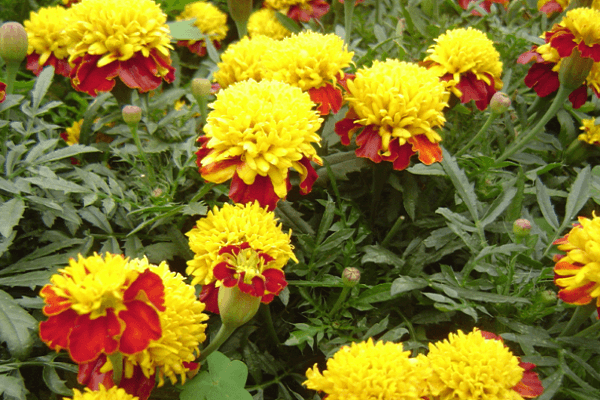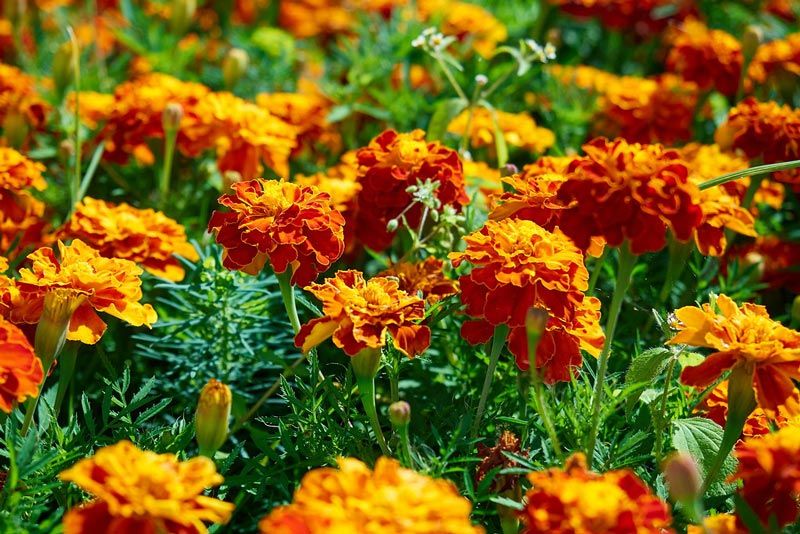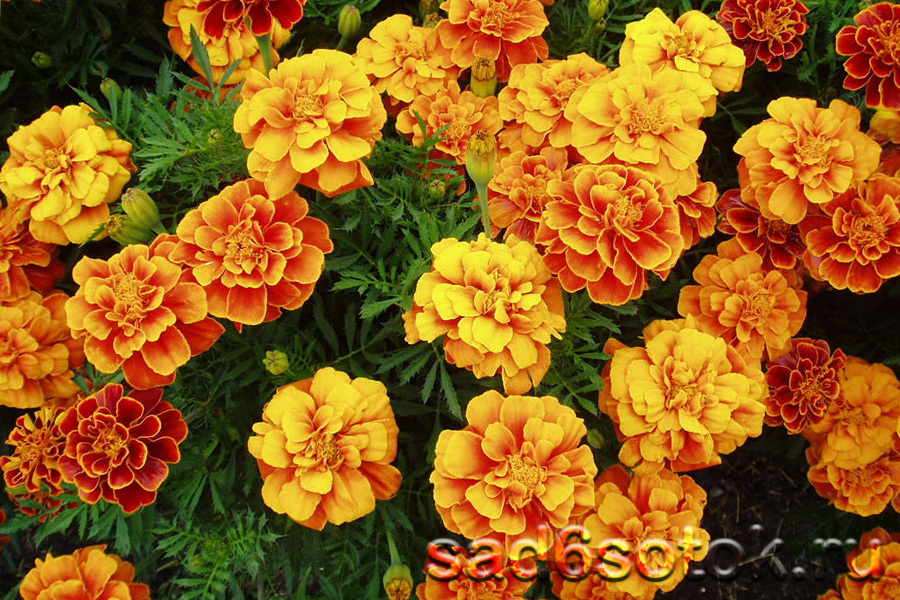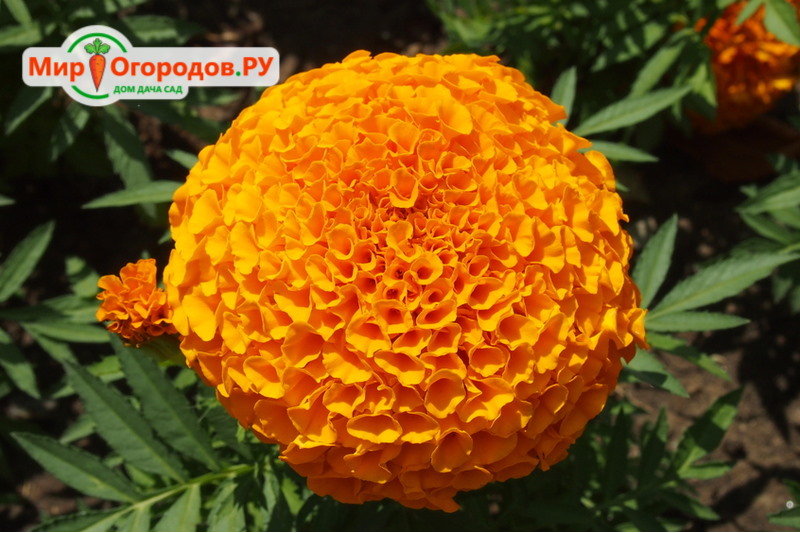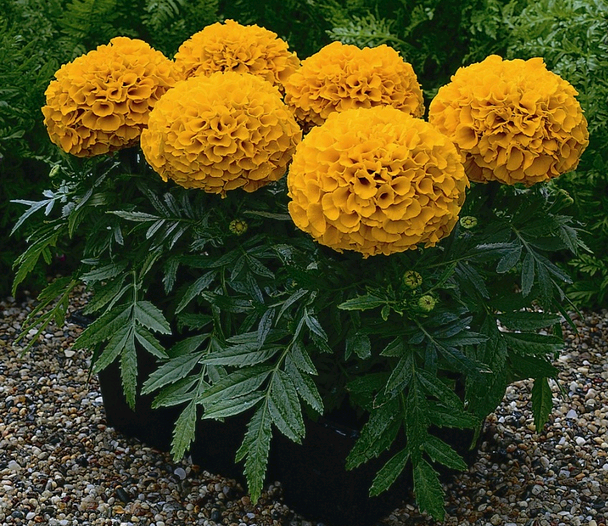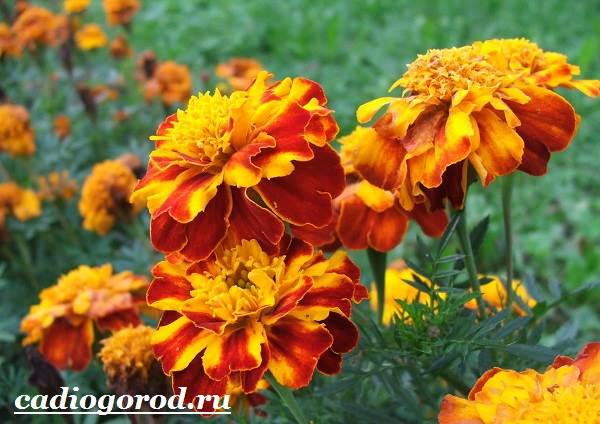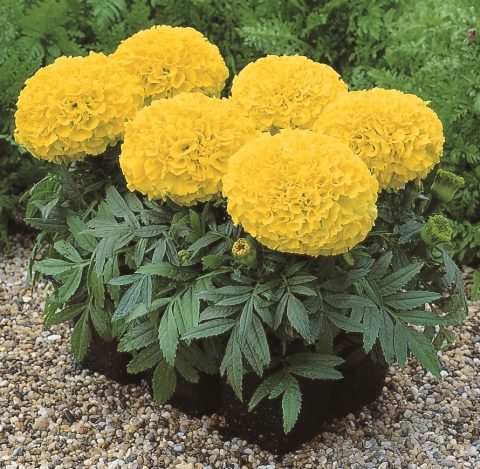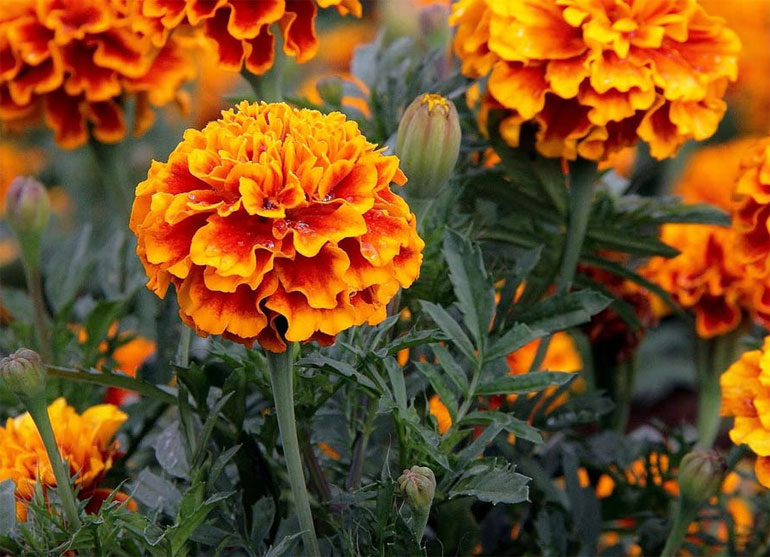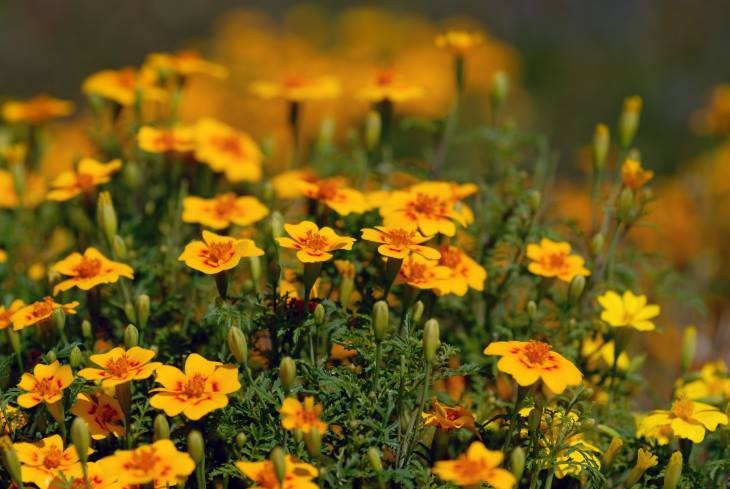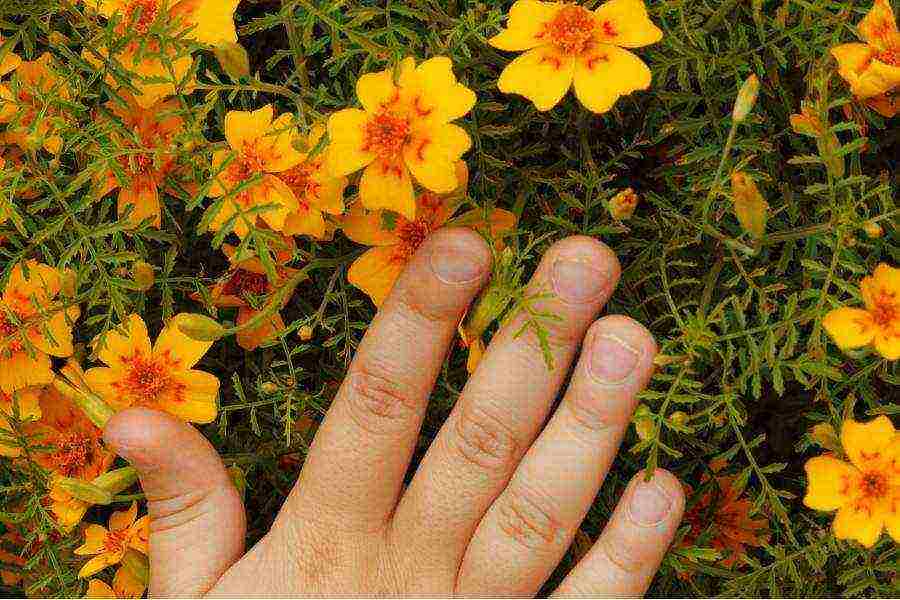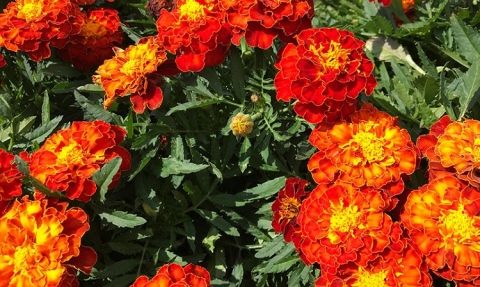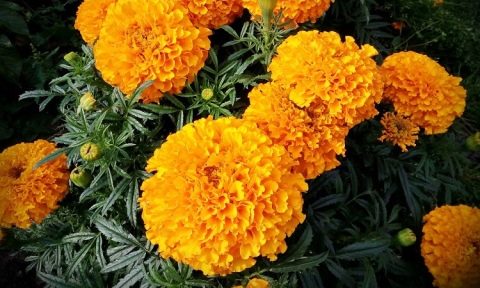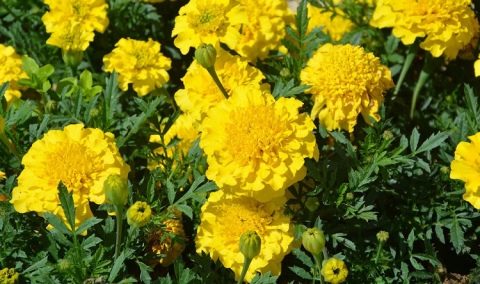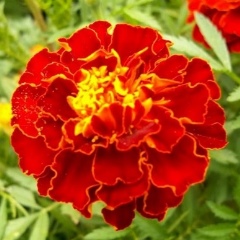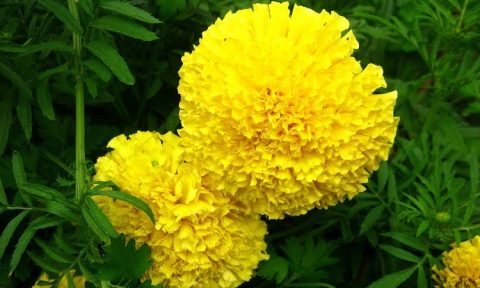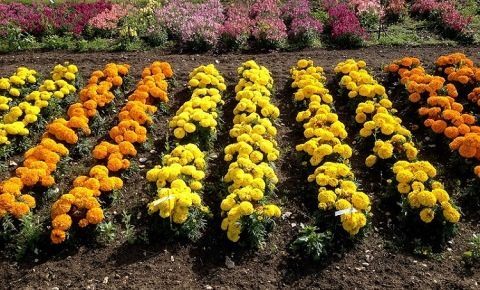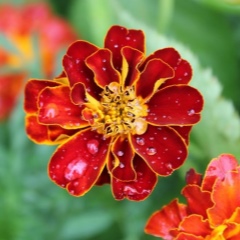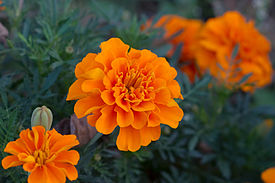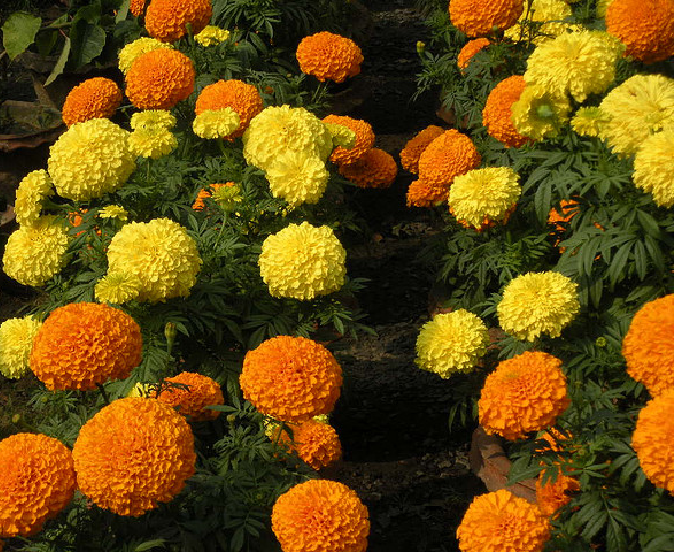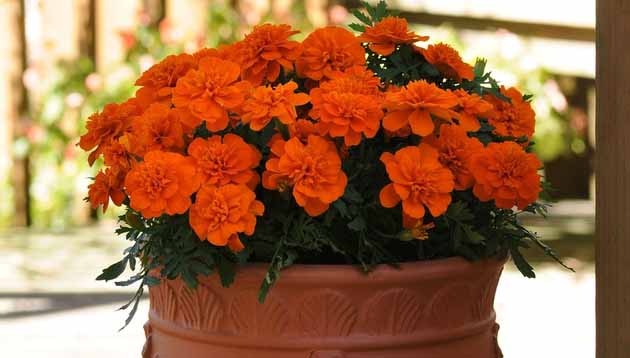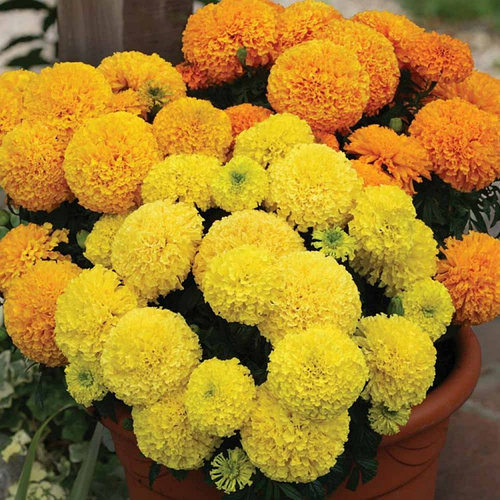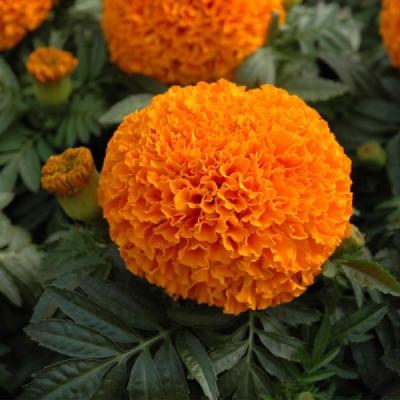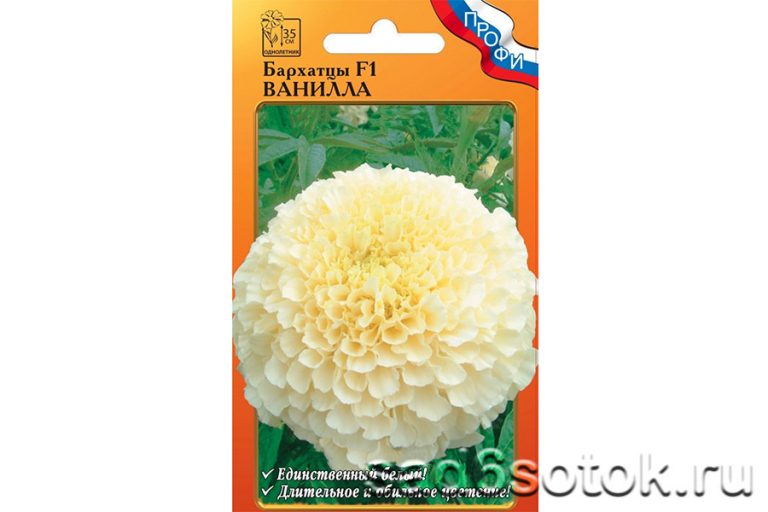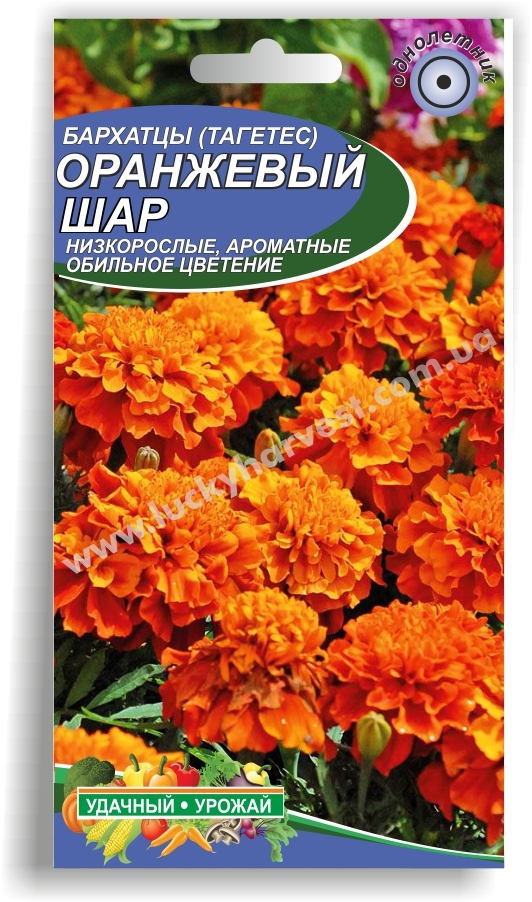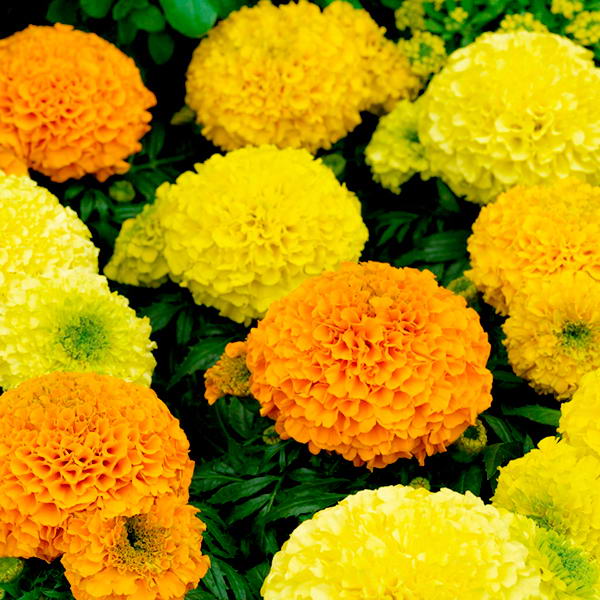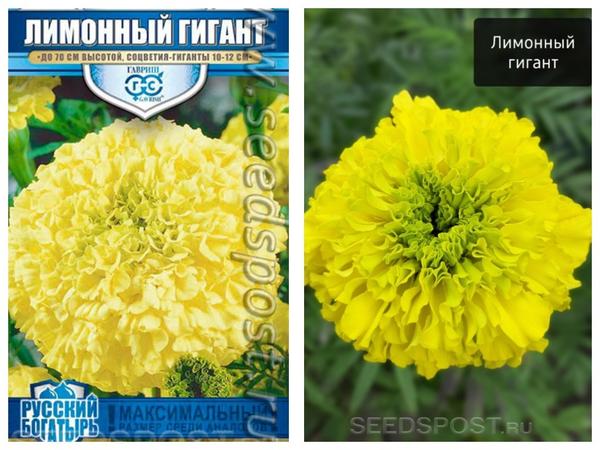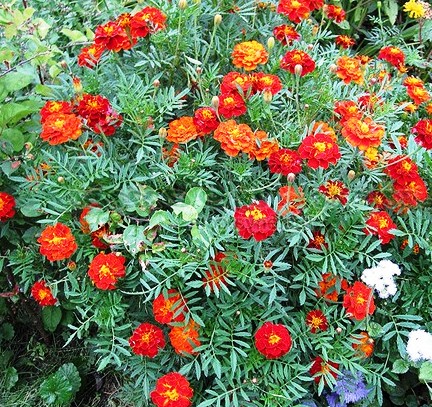Varieties of low-growing marigolds
There are about 60 species of marigolds and even more hybrid varieties obtained as a result of crossing. They are classified according to various characteristics, such as color and size of flowers. There is also a classification based on the features of the appearance and structure of the bush. According to this criterion, plants are divided into 4 groups:
- Erect - stems are massive and strong, up to 1 m high. They are also called African (Tagetes erecta).
- Thin-leaved, they are Mexican (Tagetes tenuifolia) - compact bushes up to 40 cm.
- Rejected, they are also called French (Tagetes patula) - undersized plants up to 50 cm.
Erect undersized marigolds
This variety of marigolds got its name due to the straight, strong shoots that do not bend even with gusts of wind. Such plants are characterized by good growth - they reach a height of 30 to 100 cm. They have rather large inflorescences and leaves, but flowering later, occurs in July and August.
- Among the erect plants, the following plants are distinguished:
- Calando series - compact bushes with large flowers (up to 8 cm in diameter) of yellow and orange tones. They reach a height of 45 cm.
- Variety Luxor with orange, golden and yellow petals. These varieties of low-growing marigolds bloom earlier than others, the bushes grow up to 40 cm.
Thin-leaved
These are low plants (height from 15 to 40 cm) with graceful leaves and a variety of inflorescences - monochromatic and two-colored. The following varieties are popular among florists:
- Jam (Gem) - a series of varieties of small shrubs up to 25 cm, yellow and orange petals. A characteristic feature is long flowering from late spring to September inclusive.
- Paprika (Paprica) is a compact shrub up to 20 cm high with bright red inflorescences and a yellow core.
Rejected
Small plants (up to 30–45 cm) with a variety of flowers (one-, two-color, simple and double). Represented by several interesting varieties:
- Disco Orange: early bloom with deep orange petals.
- Dainty Marietta: large bright yellow inflorescences.
- Red Marietta (Red Marietta): large inflorescences rich red tones.
- Valencia (Valensia) - golden and orange inflorescences, rather large.
- Petite (Petite) - compact bushes with a variety of colors from bright yellow to burgundy color. They are distinguished by early flowering.
- Boy (Boy) - a series of orange and yellow varieties.
- Primo (Primo) - relatively tall (up to 30 cm) marigold bushes with large orange petals.
Rejected marigolds (French) varieties
Low-growing marigold varieties belong mainly to this species. The maximum height of the bushes is 60 cm. Rejected terry marigolds abundantly cover the bushes, which, when tightly planted, form a low hedge. Therefore, they are often used for casing paths, curbs, curbs, chain-link fences and other fences. They are most often found in gardens and in personal plots. Rejected marigolds have a varied, often combined color. The inflorescences are medium in size - 3-3.5 cm in diameter. The most popular among gardeners today are marigolds, undersized large-flowered
Much attention is paid to the breeding of such varieties. Have a rather pungent odor
Of the rejected varieties, you should pay attention to:
- Gold Copchen (terry),
- Gold Ball (plain or semi-double),
- Bonanza (terry),
- Carmen (terry).
 French marigold varieties
French marigold varieties
Erect marigolds (African)
High ornamental varieties of Tagetes, inflorescences are mostly monochromatic, large (up to 15 cm), grown for cut (cut varieties). The height of the bushes is from 30 to 120 cm. All flowers are double. White marigolds for flower gourmets are erect. They look very beautiful in a flower garden both independently and with other varieties. Using the best varieties of marigolds of different types, colors and heights, you can build a multi-tiered flower bed.
Marigolds erect varieties:
- Goldlicht (large bright orange flowers),
- Kilimanjaro (a rare species of tall, white, terry marigolds),
- Eskimo (white marigolds with a bush height of about 30-40 cm),
- Sonnenschein (lemon yellow inflorescence on a relatively low bush),
- Vanilla (white, large, about 12 cm in diameter, inflorescences).
We grow marigold seedlings
If you want to get flowering plants early, then you need to sow seeds for seedlings. They do this in late March or early April, when daylight hours increase so that the marigolds have enough sun for full growth.
The primer can be selected ready-to-use or universal. If you prefer to use land from your site or forest land, then you must decontaminate it. To do this, use a pink solution of potassium permanganate, or spill it with boiling water several times. Containers can be immediately taken deeper; on the bottom it is necessary to put a drainage layer of expanded clay or other material.
In wet soil, grooves are made one centimeter deep, spread the seeds and covered with soil. Next, the crops are moistened from the pulverizer so as not to erode the soil. For germination of marigold seeds, a temperature of 20 degrees is suitable. Boxes with seedlings are covered with a film with small cuts so that moisture evaporates less.
Within about five, seven days, depending on the variety, the marigolds will sprout. Now the container can be transferred to well-lit places, with a temperature of 15-18 degrees. Most likely, in the apartment this will be a place on the windowsill. After the plants have 2-3 pairs of real leaves, the plantings can be thinned out by replanting excess plants into another container.
Seedlings are transplanted to a permanent place in the middle or at the end of May.
But flower growers should pay attention to the weather forecast and if there is a threat of frost, the plants are covered with high-density material or plastic wrap.
Planting seeds in the ground
Marigolds are easy to grow from seeds. Planting in flower beds begins at the end of May, when the soil warms up well. It is better to choose an open sunny place, far from water bodies, light partial shade is allowed. For convenience, furrows can be made with a hoe, then spilled with water.
The seeds are laid out about 1.5-2 cm from each other, and sprinkled with soil 0.5-1 cm.Further, the plantings are watered and covered with a covering material so that the moisture does not evaporate so much, of course, if rains are predicted, then this is possible and not to do.
After about five days, velvet shoots will appear, the covering tissue is removed, if there is a severe drought, the plants need watering. When the second pair of real leaves appears, the places where the marigolds have sprouted densely are thinned out. Excess plants can be planted in beds with cabbage, tomatoes, peppers, carrots. The fact is that all parts of marigolds secrete phytoncides that scare off pests and fight pathogenic microflora, including such a common fungus as late blight.
When planting these plants, depending on the variety, certain conditions are observed. So between tall marigolds, you need to adhere to a distance of about 40 cm, between medium-sized plants they stand 30 cm, and low marigolds are seated at a distance of 15-20 cm.

Varieties of varieties
This plant has a huge variety of varieties that have characteristic features. These include:

Marigolds are erect. This variety is a plant whose height is about 25 cm. They have orange and bright yellow baskets. The flower diameter is 8 cm.

Marigolds are undersized. The height of an adult bush ranges from 20 to 50 cm. They have a neat bush, which is almost entirely composed of inflorescences.

The flowering period is about 2 months from the date of planting. This variety includes varieties: "Bolero", "Orange" and others.

Marigolds are thin-leaved.These flowers have beautiful decorative leaves. The aroma has subtle spicy notes that have a positive effect on human health.

The inflorescences are combined into numerous rosettes, which, when viewed visually, look like large baskets. Marigold flowers in the photo reflect all the beauty of this breed.


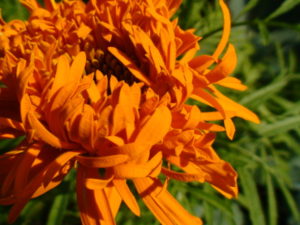
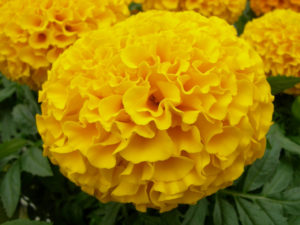
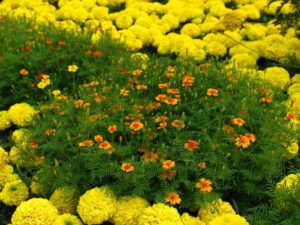
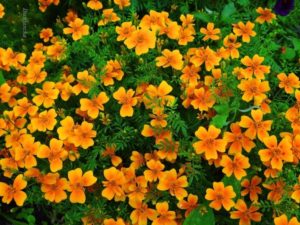
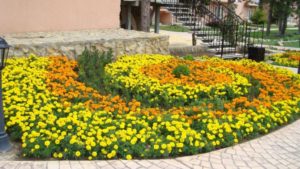
Red undersized marigolds
Red low-growing marigolds are the most attractive, therefore they are often used to organize space (dividing different zones of the garden with borders, planting along paths). These flowers are appropriate in mixborders and in flower beds, in flower beds and other compositions.
Red Brocada
Red brocade is a very beautiful undersized bush (up to 20 cm) with lush double flowers of a dark red hue. Petals are openwork, with an orange border; the core of the flower is yellow. Also, inflorescences can be of a rich orange color - such plants resemble lights. The diameter of the flowers is 5 cm. The flowering period is from mid-June to early October.
Red brocade double flowers attract attention thanks to their deep red delicate petals
Red cherry
Red cherry (Red cherry) undersized marigolds (up to 30 cm) with rather large inflorescences (5-6 cm in diameter) rich orange, light cherry color. Flowering begins early - in May. The plant resists adverse weather conditions well, withstands temperature extremes, drought and lack of sufficient sunlight.
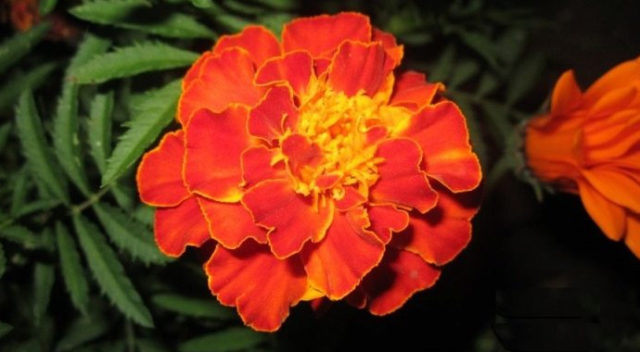 Flowers of the Red Cherry variety are double, with a yellow core and orange-red petals
Flowers of the Red Cherry variety are double, with a yellow core and orange-red petals
Aspen red
Aspen Red (Aspen Red) - undersized marigolds (up to 25 cm) with red inflorescences (diameter up to 5 cm). Flowering lasts all summer, the variety is undemanding to growing conditions. The bush is quite sprawling, so the optimal distance between neighboring plants is 30 cm.
Aspen Red petals are distinguished by their bright color and graceful shape
Red gem
Red gem - this variety of low-growing marigolds appeared relatively recently. The bush is low - up to 30 cm, the flowers are small - up to 2 cm in diameter. The plant is densely covered with red-brown, brick-colored inflorescences (the core is yellow).
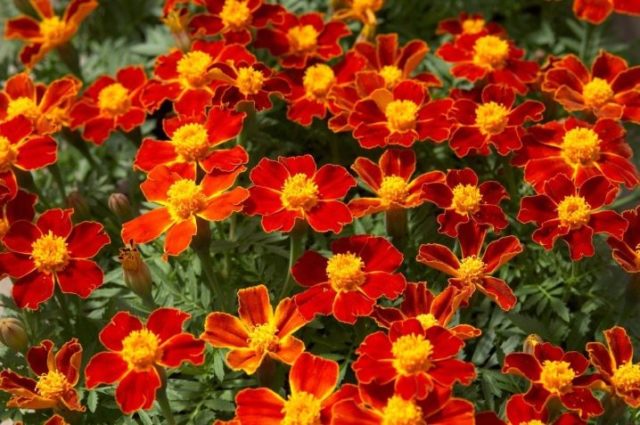 A variety of low-growing marigolds Red gem can only be planted in an open, sunny area
A variety of low-growing marigolds Red gem can only be planted in an open, sunny area
Tango red
Tango red (tango red) - compact undersized bushes (up to 20 cm tall), rather neat. They grow evenly, therefore they do not require any formation. Inflorescences appear from June to October. The shade is deep red, closer to beetroot.
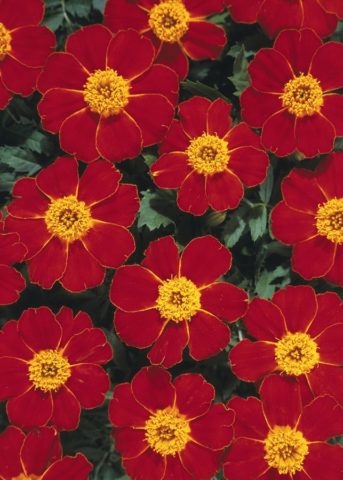 Tango Red is a warm and light-loving variety. It does not tolerate frost and prolonged absence of sunlight.
Tango Red is a warm and light-loving variety. It does not tolerate frost and prolonged absence of sunlight.
Cultivation of culture
How to plant marigolds? This question interests all novice summer residents. The main advantage of these colors is their simplicity. In some cases, you can transplant a large plant bush that will take root in a new location. When to plant marigolds?

The first step is to prepare seeds for planting. They are harvested in late autumn, after the flowering process. It is necessary to store the planting material in a dark and cool place. You should also avoid high humidity, which can provoke the formation of mold.

When to plant marigolds in the ground? The planting process is carried out in the spring season, when the soil is finally warmed up. Most experienced gardeners prefer to grow flower seedlings first. To do this, dry seeds are placed in a small pot of earth. After a while, shoots appear.



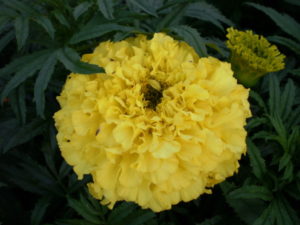
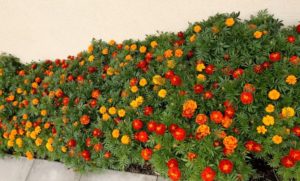
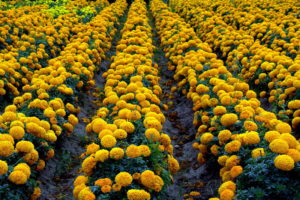
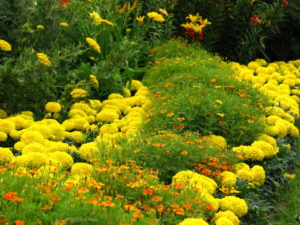

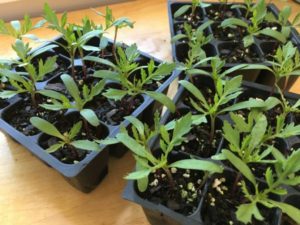


Planting and caring for marigold flowers does not require much effort. Marigolds are planted in the ground at a shallow depth of 5-8 cm.Do not bury these flowers too deeply. The root collar should be at ground level.

The main requirement of this breed is timely watering. As a rule, it is carried out as the earthen coma dries out.

The presence of weeds in the flowerbed among these flowers is not encouraged. The fact is that they can have a negative impact on the growth process of this culture, creating shaded areas in the flower bed.

Low-growing marigolds: varieties with photos and names
Queen Sofia
Marigolds from 20 to 30 cm in height bloom with terry bronze-orange flowers with a diameter of up to seven to eight centimeters. At the edges, the flowers have a golden hue. Numerous buds are formed on compact bushes.
It is not recommended to plant the Queen Sophia variety in an area with direct sunlight, as the petals fade and lose their brightness.
Carmen
Tagetes Carmen are distinguished by red-brown flowers with a yellow center. The petals of the flowers are carnation. On the spreading bushes, many buds are formed, which is why the leaves are sometimes not even visible.
A flower bed with Carmen marigolds turns out to be very elegant. Flowers will decorate the garden until the very cold weather and can leave blooming under the snow.
Antigua
The variety of low-growing large-flowered marigolds Antigua is a bush only about 20 cm high, on which buds bloom with a diameter of 6 to 12 cm.The difference in this variety is that many flowers do not bloom on it at once, but only one large spherical bud blooms. The color of the flowers can be lemon, orange, lemon yellow.
The Tagetes variety Antigua is the best suited for growing along curbs and along the edge of the flower bed. It can be grown in pots and boxes, decorating balconies, verandas, gazebos with elegant flowers.
Naughty Marietta
Tagetes varieties Playful Marietta are distinguished by compact bushes about 30 cm high. They have non-double flat flowers with a very beautiful color. The petals are red-brown in the center, and golden-yellow at the edges. The diameter of the buds reaches 5 cm. A large number of flowers form and bloom on the plants at the same time.
Tiger's Eye
Marigolds of the Tiger Eye variety got their name because of the color of the flowers. A double large orange center is framed by red-brown petals. Flowers with a diameter of about 6 cm are formed on branched bushes up to 35 cm high.
Tagetes Eye of the Tiger look good in the same flowerbed with cineraria and primroses, they can be grown in boxes and flowerpots.
Red gem
Abundantly flowering tagetes are spreading bushes with bright flowers. Around the yellow center of the flowers, there are 5-6 rich red petals. Low plants have a height of about 20 cm. If only marigolds of the Red Gem variety are planted on a flower bed, during their flowering it will seem that there is a beautiful bright carpet on the site.
Red brocade
Low-growing large-flowered marigolds of the Red Brocade variety adorn the garden or balcony with their large double bright flowers up to 6 cm in diameter... The color of the flowers is brown-red. Their petals are interesting because they are almost orange underneath. Compact bushes of Tagetes Red brocade are about 25 cm high.
In order for marigolds to form more and more new buds, faded flowers must be removed immediately. In this case, the flowering of Tagetes will be abundant.
Did you know that marigolds have not only decorative, but also medicinal properties? You can read about them in our article: Marigold: medicinal properties and contraindications.
Perennial marigolds. Planting and caring for marigolds
Tagetis is a sun- and heat-loving plant. In Mexico, America and Africa, where marigolds grow naturally, it is perennial. In our climatic conditions, marigolds can only be grown as annuals, because they are not able to overwinter in the soil. The perennial effect creates the fact that marigolds abundantly throw out their seeds, which do not lose their vitality over the winter and in the spring sprout on their own in the same place.
In open ground, marigolds are planted with seedlings or seeds.You will need to start sowing seedlings in February. This option is suitable for "industrial production" for the purpose of centralized landscaping of large cities, when small bushes of seedlings with the first flowers are planted in the ground. At home, marigolds are planted with seeds immediately in open ground in May, and in early June they already begin to bloom. Marigolds are very unpretentious: they feel good both in the shade and in the sun, they are unpretentious to watering, they can be transplanted without harm even during the flowering period.
After the inflorescence dries, do not forget to collect the seeds so that the flowers will delight you next year. Marigolds are cross-pollinated. If you have planted varietal marigolds of different colors in one place, then be prepared for the fact that by planting the collected seeds next year, you can get a completely new and completely unexpected inflorescence color. Therefore, in order to preserve the color of varietal marigolds, it is necessary to prevent them from pollination with flowers of a different color. To do this, bushes of different colors must be planted in a flower bed as far as possible from each other.
Classification
In the 16th century from America to Europe, the conquistadors brought a bright fragrant flower with a color reminiscent of the sun's rays, which later spread throughout Europe and Asia. Karl Linnaeus, together with a description of the plant in the middle of the 18th century, gave it the Latin name Tagétes. In Russia, these flowers are called marigolds because of the petals that resemble bright patches of delicate velvet. In other countries, they are called "Turkish carnation", "student flower", "Marigolds", which means "Mary's gold", or "black-haired".
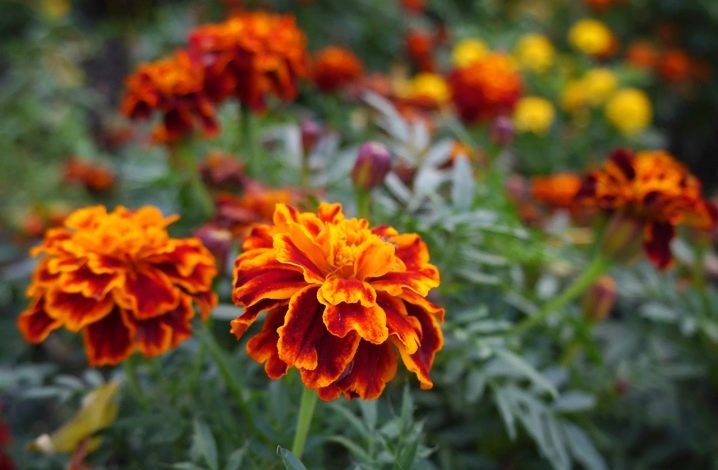
Marigolds belong to the Compositae family, being relatives of asters. A herbaceous plant, cultivated mainly as an annual, forms a bush of upright branchy shoots from 0.2 m in height in dwarf species, to real giants, raising their flowers at a distance of more than a meter above the ground.
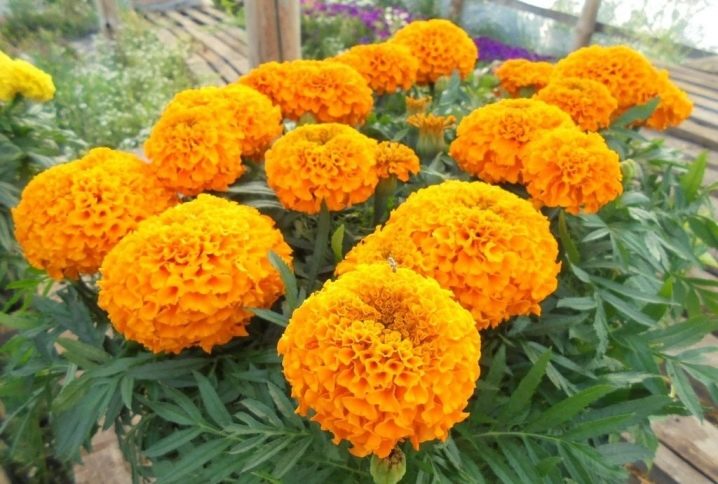
The root of the Tagetes in the form of a highly branched rod provides reliable support and nutrition for a heavy bush.
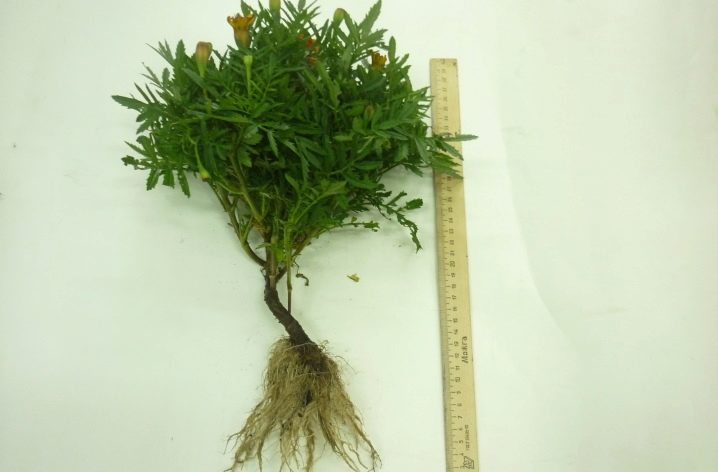
Strongly flattened, elongated seeds of a dark brown, almost black color, ripening in cylindrical capsules formed by closed sepals, remain viable for several years. Perennial species of "Turkish carnation" can reproduce by self-seeding. Ripe seeds, falling to the ground, easily endure the winter, covered with a snow blanket, in order to start growing early in spring, forming dense shoots of young plants.
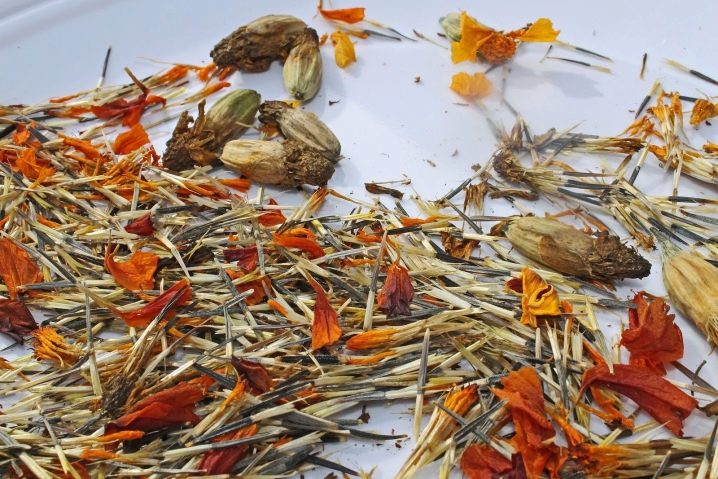
The flower has a pronounced odor that can repel pests and cause an allergic reaction in humans. Not only the buds have a specific aroma, but also the leaves of the plant, which can smell even stronger than a blossoming flower.
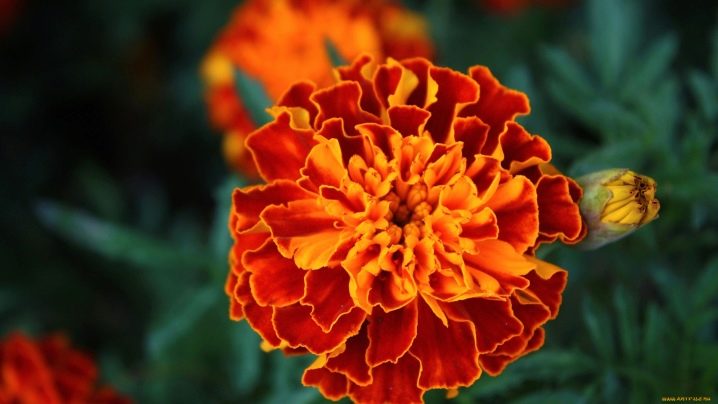
By the shape of the leaves
The leaves of marigolds are pinnate, separate or dissected, although they are found whole, with characteristic denticles along the edge of the plate. Structural veins are clearly visible against the background of greenery of various shades from light to dark.
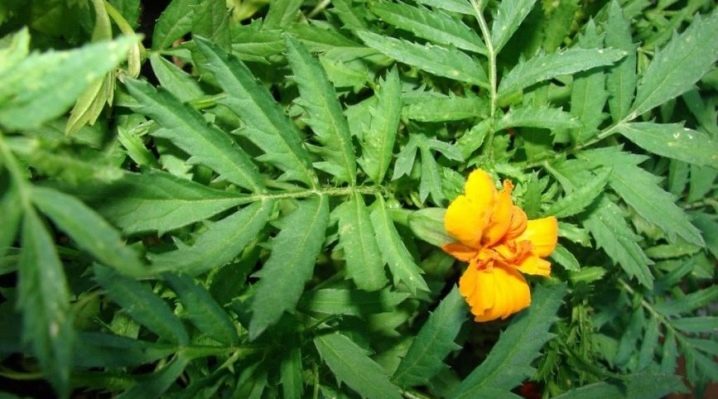
By the shape and number of petals
The characteristic varietal feature of the plant is the shape and number of petals:
- cloves have reed-shaped petals;
- chrysanthemum with large tubular petals;
- the anemone ones combine the features of two types: the middle is formed from tubular petals, along the edge there are two rows of reed petals.
A basket-shaped inflorescence can resemble in shape the structure of a chamomile flower: be semi-double with a small number of rows of flower leaves or double, tightly filled with petals of the same type, or combined.

